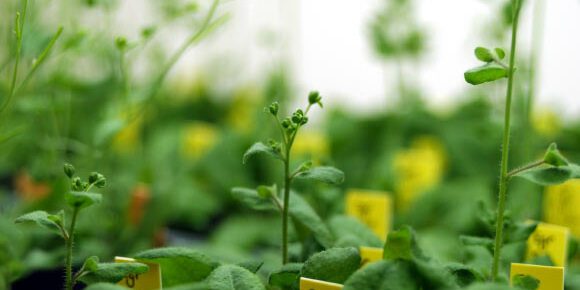DNA methylation is one of several epigenetic mechanisms crucial for regulating gene expression in eukaryotic organisms.
Arabidopsis thaliana. Image credit: Carl Davies, CSIRO / CC BY 3.0.
DNA methylation is a normal biological process in living cells wherein small chemical groups called methyl groups are added to DNA.
This activity controls which genes are turned on and off, which in turn affects different traits — including how organisms respond to their environments.
Part of this job involves silencing, or turning off, certain snippets of DNA that move around within an organism’s genome.
These so-called jumping genes, or transposons, can cause damage if not controlled.
The entire process is regulated by enzymes, but mammals and plants have developed different enzymes to add methyl groups.
“Mammals only have two major enzymes that add methyl groups in one DNA context, but plants actually have multiple enzymes that do that in three DNA contexts,” said Professor Xuehua Zhong, a researcher at Washington University in St. Louis.
“This is the focus of our study. The question is — why do plants need extra methylation enzymes?”
“Certain genes or combinations of genes are contributing to certain features or traits.”
“If we find precisely how they are regulated, then we can find a way to innovate our technology for crop improvement.”
Professor Zhong and her colleagues focused on two enzymes specifically found in plants: CMT3 and CMT2.
Both enzymes are responsible for adding methyl groups to DNA, but CMT3 specializes in the parts of DNA called the CHG sequences, while CMT2 specializes in different parts called CHH sequences.
Despite their functional differences, both enzymes are a part of the same chromomethylase (CMT) family, which evolved through duplication events that provide plants with additional copies of genetic information.
Using a common model plant called the thale cress (Arabidopsis thaliana), the study authors investigated how these duplicated enzymes evolved different functions over time.
They discovered that somewhere along the evolutionary timeline, CMT2 lost its ability to methylate CHG sequences. This is because it’s missing an important amino acid called arginine.
“Arginine is special because it has charge,” said Jia Gwee, a graduate student at Washington University in St. Louis.
“In a cell, it’s positively charged and thus can form hydrogen bonds or other chemical interactions with, for example, the negatively charged DNA.”
“However, CMT2 has a different amino acid valine. Valine is not charged, so it is unable to recognize the CHG context like CMT3. That’s what we think contributes to the differences between the two enzymes.”
To confirm this evolutionary change, the researchers used a mutation to switch arginine back into CMT2.
As they expected, CMT2 was able to perform both CHG and CHH methylation. This suggests that CMT2 was originally a duplicate of CMT3, a backup system to help lighten the load as DNA became more complex.
“But instead of simply copying the original function, it developed something new,” Professor Zhong said.
This research also provided insights about CMT2’s unique structure.
The enzyme has a long, flexible N-terminal that controls its own protein stability.
“This is one of the ways plants evolved for genome stability and to fight environmental stresses,” Professor Zhong said.
“This feature may explain why CMT2 evolved in plants growing in such a wide variety of conditions worldwide.”
The results appear today in the journal Science Advances.
_____
Gwee et al. 2024. Science Advances, in press; doi: 10.1126/sciadv.adr2222
This post was originally published on here







